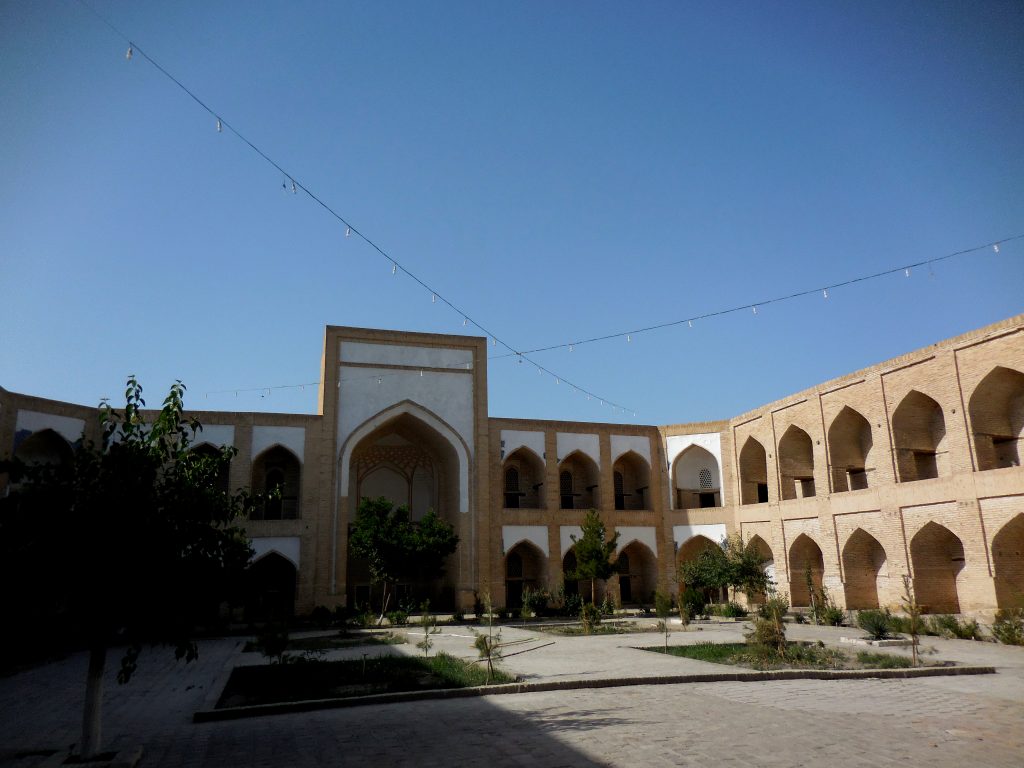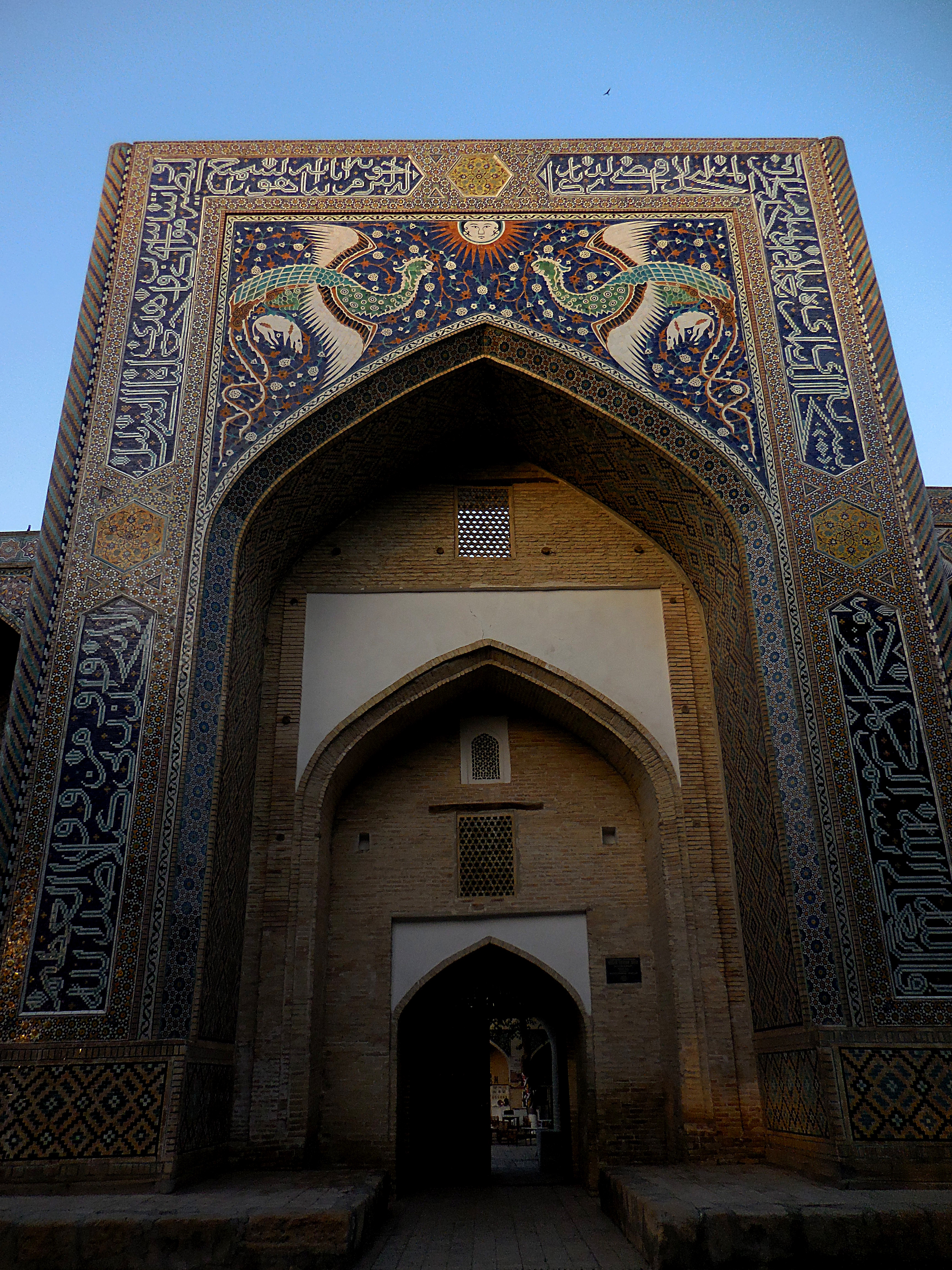Madras Kukeldash, Khanaka and Madras Nadir Divan-Begi, Bukhara.
Madras Kukeldash, Khanaka and Madras Nadir Divan-Begi, Bukhara.
Lyabi-Hauz is one of the squares in Bukhara’s center, used in ancient times as a place of commercial exchange. Today in the center there is an artificial pool, around which families gather in the evening hours under the tall green trees, sitting at the tables of the various local Café.
Around the square there are three important buildings: the Madras Kukeldash in the North area (1568-69); Khanaka Nadir Divan-Begi to the West (1620) and the Madras Nadir Divan-Begi to the East (1620).
Madras Kukeldash

Built during the reign of Khan Abdullah II in the sixteenth century, the Madras is one of the largest in the city (80 x 60 meters). The walls count two orders in which 160 cells were erected, as well as a darskhana (great hall) and an internal Mosque.
Active until the last century, the Madras formed illustrious intellectuals and writers throughout Central Asia, as Sadriddin Ayni (1878-1954); despite having changed its function several times over the centuries, also as a place of storage of caravans in the eighteenth century.
The entrance façade is decorated with turquoise mosaics and complex geometries, all made without the use of glue. In the interior, the cells and arches are in simple style, with stucco decorations. There are also star-shaped street lamps made with burnt bricks. The decorations of the main rooms and the internal mosque are also noteworthy.
Khanaka Nadir Divan-Begi
Call Nadir by the name of the governor who ordered its construction at the beginning of the seventeenth century, during the Ashtarkhanidi dynasty; this khanaka served as a place of spiritual retreat for the Sufis.
The architecture is the only one of its kind in Bukhara due to the cross-shaped dome, which overlooks the main rectangular hall, already visible from the steps of the high and narrow entrance hall. The façade is decorated with turquoise epigraphic motifs and the walls end in two low cylindrical towers of the same height.
Inside is a richly decorated mihrab (niche for prayer) and a museum with period photographs, some paintings and a model of the city. Thanks to the particular internal acoustics, the khanaka has long been the cultural and religious center of Bukhara.
Madras Nadir Divan-Begi

In my humble opinion, the most elegant of all, the Madras Nadir Divan-Begi was built together with the Khanaka always under the order of Governor Nadir to be used as a caravan depot. The Khan Imamkuli, however, decreed to change the function of the building in Madras, since it was built “in the name of Allah”. Portals, towers, terraces and the higher order with the cells for the students were therefore added; all completed in 1630.
The double order of the cells is already visible in the external façade, where the arch of the portal is finely decorated with two white and turquoise birds in flight; as well as lateral Koran writings and predominant phytoform motifs on the cobalt blue background. The facade resumes the Samarkand Madras Sher-Dor, but instead of the tigers there are the birds of happiness and the anthropomorphic sun stands out above the central point of the arch. The entrance has an elongated shape, not usual for Islamic architecture of the period.
The interior has lost some of its charm due to the fact that the courtyard is used as a sales space, concerts and performances for numerous tourists; tables are left everywhere even when the monument should be “free”.
Legend on the Lyabi-Hauz complex

A legend tells how the governor Nadir Divan-Begi had given his wife a pair of earrings for their marriage; which, according to the customs of the time, was considered very little. However, the wife remained silent, although she was offended by the small amount of gifts received for her wedding.
Seeing him use so many resources for the construction of the Madras, the Khanata and other buildings, his wife decided to scold him, reproaching him for having received only the earrings as a wedding gift. In response, Nadir asked her to open the casket where the jewels were kept and the wife noticed that one of the earrings was missing. Nadir explained that he had taken the earring because with his value he had been able to build everything: “You did not understand the value of my gift, now you can appreciate what I have built with one of the earrings …”
For more information on what to visit in Bukhara, click here. Site address.
Foto of Eva Zalesakova
Source: A.V., Bukhara, the city and the legends, Davr Nashriyoti, Tashkent, 2014


Pingback: The Samonids Mausoleum and the Magoki Attari Mosque, Bukhara.
Pingback: Mausoleo Samani, Moschea Magoki Attari | Erica Leoni
Pingback: The Samonids Mausoleum and the Magoki Attari Mosque, Bukhara. | Erica Leoni